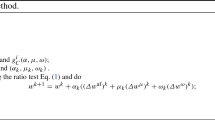Abstract
Many problems arising in practical applications lead to linear programming problems. Hence, they are fundamentally tractable. Recent interior-point methods can exploit problem structure to solve such problems very efficiently. Infeasible interior-point predictor–corrector methods using floating-point arithmetic sometimes compute an approximate solution with duality gap less than a given tolerance even when the problem may not have a solution. We present an efficient verification method for solving linear programming problems which computes a guaranteed enclosure of the optimal solution and which verifies the existence of the solution within the computed interval.
Similar content being viewed by others
References
G.E. Alefeld and J. Herzberger, Introduction toInterval Computations (Academic Press, New York, 1983).
A.V. Fiacco and G.P. McCormick, Nonlinear Programming: Sequential Unconstraint Minimization Techniques, SIAM Classics in Applied Mathematics, Vol. 4 (SIAM, Philadelphia, PA, 1990).
R.K. Frisch, The logarithmic potential method of convex programming, Memorandum, University Institute of Economics, Oslo (1955).
I.I. Idriss, Verified linear programming in control system analysis and design, Dissertation, Dresden University of Technology (2001).
N.K. Karmarkar, A new polynomial-time algorithm for linear programming, Combinatorica 4 (1984) 373–395.
R.B. Kearfott, Rigorous Global Search: Continuous Problems (Kluwer Academic, Dordrecht, 1996).
M. Kojima, S. Mizuno and A. Yoshise, A primal-dual interior-point algorithm for linear programming, in: Progress in Mathematical Programming: Interior Point and Related Methods, ed.N. Megiddo (Springer, New York, 1989) pp. 29–47.
R. Krawczyk, Newton-Algorithmen zur Bestimmung von Nullstellen mit Fehlerschranken, Computing 4 (1969) 187–201.
N. Megiddo, Pathways to the optimal set in linear programming, in: Progress in Mathematical Programming:Interior Point and Related Methods, ed. N. Megiddo (Springer, New York, 1989) pp. 131–158.
S. Mehrotra, On the implementation of a primal-dual interior-point method, SIAM J. Optim. 2(4) (1992) 575–601.
R.E. Moore, A test for existence of solutions to nonlinear systems, SIAM J. Numer. Anal. 14 (1977) 611–615.
A. Neumaier, Interval Methods for Systems of Equations (Cambridge Univ. Press, London, 1990).
C. Roos, J.P. Vial and T. Terlaky, Theory and Algorithms for Linear Optimization: An Interior Point Approach (Wiley, New York, 1997).
W.V. Walter, FORTRAN-XSC: A portable Fortran 90 module library for accurate and reliable scientific computing, in: Validation Numerics-Theory and Application, Vol. 9, Computing Supplementum, eds. R. Albrecht, G. Alefeld and H.J. Stetter (Springer, Vienna, 1993) pp.265–285.
Author information
Authors and Affiliations
Rights and permissions
About this article
Cite this article
Idriss, I.I., Walter, W.V. Validated Infeasible Interior-Point Predictor–Corrector Methods for Linear Programming. Numerical Algorithms 37, 177–185 (2004). https://doi.org/10.1023/B:NUMA.0000049465.66643.ce
Issue Date:
DOI: https://doi.org/10.1023/B:NUMA.0000049465.66643.ce




